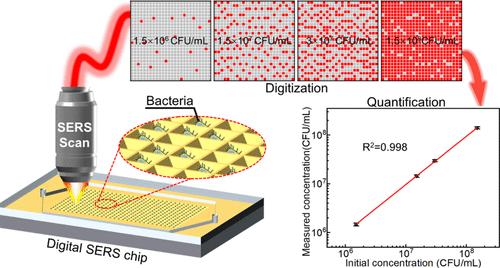Our official English website, www.x-mol.net, welcomes your
feedback! (Note: you will need to create a separate account there.)
Microcavity Array-Based Digital SERS Chip for Rapid and Accurate Label-free Quantitative Detection of Live Bacteria
ACS Sensors ( IF 8.2 ) Pub Date : 2024-11-04 , DOI: 10.1021/acssensors.4c02007 Ping Wen, Feng Yang, Haixia Zhao, Shunbo Li, Yi Xu, Li Chen
ACS Sensors ( IF 8.2 ) Pub Date : 2024-11-04 , DOI: 10.1021/acssensors.4c02007 Ping Wen, Feng Yang, Haixia Zhao, Shunbo Li, Yi Xu, Li Chen

|
In this study, we developed a novel digital surface-enhanced Raman spectroscopy (SERS) chip that integrates an inverted pyramid microcavity array, a microchannel cover plate, and a multilayer gold nanoparticle (AuNP) SERS substrate. This innovative design exploits the synergistic effects of the microcavity array and the microchannel to enable rapid and large-scale digital discretization of bacterial suspensions. The concentration effect of the picoliter cavities, combined with the superior Raman enhancement effect of the multilayer AuNP SERS substrate, allows for the precise identification of live bacteria within the microcavities through in situ and label-free SERS testing after a short incubation period. By counting the resulting positive or negative signals, the concentration of the target analyte can be directly determined via Poisson statistics. Experimental results demonstrate that this method enables the accurate quantification of Escherichia coli (E. coli) BL21 within a 4-h incubation period. Compared with traditional analog SERS detection methods, our proposed digital SERS detection strategy reduces the impact of signal intensity fluctuations, thereby significantly improving detection efficiency and accuracy. We believe that this digital SERS chip has great application prospects in the fields of bacterial detection, antibiotic resistance analysis, and cellular dynamics monitoring.
中文翻译:

基于微腔阵列的数字 SERS 芯片,用于快速、准确地无标记定量检测活细菌
在这项研究中,我们开发了一种新型数字表面增强拉曼光谱 (SERS) 芯片,该芯片集成了倒金字塔微腔阵列、微通道盖板和多层金纳米颗粒 (AuNP) SERS 衬底。这种创新设计利用了微腔阵列和微通道的协同效应,实现了细菌悬浮液的快速和大规模数字离散化。皮升腔的浓缩效应,结合多层 AuNP SERS 基板的卓越拉曼增强效果,允许在短暂的孵育期后通过原位和无标记的 SERS 测试精确识别微腔内的活细菌。通过计算得到的阳性或阴性信号,可以通过泊松统计直接确定目标分析物的浓度。实验结果表明,该方法能够在 4 小时孵育期内准确定量大肠杆菌 (E. coli) BL21。与传统的模拟 SERS 检测方法相比,我们提出的数字 SERS 检测策略减少了信号强度波动的影响,从而显著提高了检测效率和准确性。我们相信,该数字 SERS 芯片在细菌检测、抗生素耐药分析和细胞动力学监测领域具有很大的应用前景。
更新日期:2024-11-05
中文翻译:

基于微腔阵列的数字 SERS 芯片,用于快速、准确地无标记定量检测活细菌
在这项研究中,我们开发了一种新型数字表面增强拉曼光谱 (SERS) 芯片,该芯片集成了倒金字塔微腔阵列、微通道盖板和多层金纳米颗粒 (AuNP) SERS 衬底。这种创新设计利用了微腔阵列和微通道的协同效应,实现了细菌悬浮液的快速和大规模数字离散化。皮升腔的浓缩效应,结合多层 AuNP SERS 基板的卓越拉曼增强效果,允许在短暂的孵育期后通过原位和无标记的 SERS 测试精确识别微腔内的活细菌。通过计算得到的阳性或阴性信号,可以通过泊松统计直接确定目标分析物的浓度。实验结果表明,该方法能够在 4 小时孵育期内准确定量大肠杆菌 (E. coli) BL21。与传统的模拟 SERS 检测方法相比,我们提出的数字 SERS 检测策略减少了信号强度波动的影响,从而显著提高了检测效率和准确性。我们相信,该数字 SERS 芯片在细菌检测、抗生素耐药分析和细胞动力学监测领域具有很大的应用前景。


















































 京公网安备 11010802027423号
京公网安备 11010802027423号